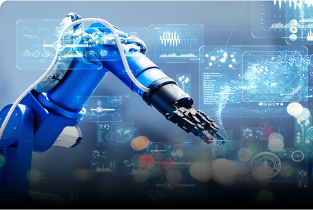The world of technology is evolving rapidly, and three major fields—embedded systems, the Internet of Things (IoT), and robotics—are playing a crucial role in shaping our future. While they may seem like distinct domains, they are deeply interconnected and often work together to power modern smart devices, automation systems, and intelligent machines. Let’s explore how these fields intersect and influence each other.
Understanding Embedded Systems, IoT, and Robotics
1. Embedded Systems: The Core of Smart Devices
An embedded system is a specialized computing system designed to perform dedicated functions within a larger device. These systems integrate hardware and software and are typically optimized for real-time processing, efficiency, and reliability.
Examples of embedded systems include:
- Microcontrollers in washing machines
- Real-time controllers in medical devices
- Automotive ECU (Electronic Control Unit) systems
2. Internet of Things (IoT): Connecting Devices to the Cloud
The Internet of Things (IoT) is a network of interconnected devices that communicate and exchange data over the internet. These devices use sensors, embedded systems, and cloud computing to collect, analyze, and transmit data.
Examples of IoT applications:
- Smart home automation (e.g., smart thermostats, security cameras)
- Wearable health devices (e.g., fitness trackers, smartwatches)
- Industrial IoT (IIoT) in smart manufacturing
3. Robotics: The Intelligence Behind Automation
Robotics involves designing, building, and operating intelligent machines that can perform tasks autonomously or semi-autonomously. Robots rely on embedded systems for control, IoT for connectivity, and artificial intelligence (AI) for decision-making.
Examples of robotics applications:
- Autonomous vehicles
- Industrial robots in manufacturing
- Medical robots for surgery and patient care
How Embedded Systems, IoT, and Robotics Work Together
1. Embedded Systems Power IoT and Robotics
Embedded systems act as the brain of both IoT devices and robots. They handle data collection, processing, and communication while ensuring efficient operation.
- In IoT, embedded systems process sensor data and send it to the cloud for further analysis.
- In robotics, embedded processors control actuators, sensors, and communication modules to enable movement and decision-making.
2. IoT Enhances Robotics with Connectivity
IoT enables robots to connect to cloud platforms, access data, and make smarter decisions in real time. With IoT integration, robots can:
- Receive updates and commands remotely.
- Share sensor data for predictive maintenance.
- Collaborate in smart factories for industrial automation.
3. Robotics Brings Automation to IoT Applications
While IoT focuses on data exchange, robotics introduces autonomous actions based on that data. For instance:
- Smart IoT sensors in agriculture detect soil moisture levels, and robotic irrigation systems water crops accordingly.
- IoT-connected surveillance cameras detect motion, and security robots respond to threats.
Real-World Applications of This Interconnection
1. Smart Manufacturing (Industry 4.0)
Factories use embedded systems for machine control, IoT for remote monitoring, and robotics for automation. Together, they enhance efficiency, reduce downtime, and improve production quality.
2. Healthcare and Medical Devices
Medical robots, such as surgical assistants, use embedded systems for precision control. IoT connectivity allows doctors to monitor patient data remotely, while AI-powered robots assist in diagnostics and surgeries.
3. Autonomous Vehicles and Drones
Self-driving cars and drones integrate embedded systems for real-time navigation, IoT for traffic and weather updates, and robotics for autonomous movement and decision-making.
The Future of Embedded Systems, IoT, and Robotics
As technology advances, the integration of AI, 5G, and edge computing will further enhance the synergy between embedded systems, IoT, and robotics. Future innovations could lead to:
- More autonomous and intelligent robots.
- Smarter and more energy-efficient IoT networks.
- Advanced embedded systems with AI-driven processing capabilities.
Conclusion
Embedded systems, IoT, and robotics are interconnected technologies driving the future of automation, smart cities, and intelligent devices. Embedded systems serve as the backbone, IoT provides connectivity, and robotics brings intelligence and automation. Together, they form the foundation for groundbreaking innovations across industries.

